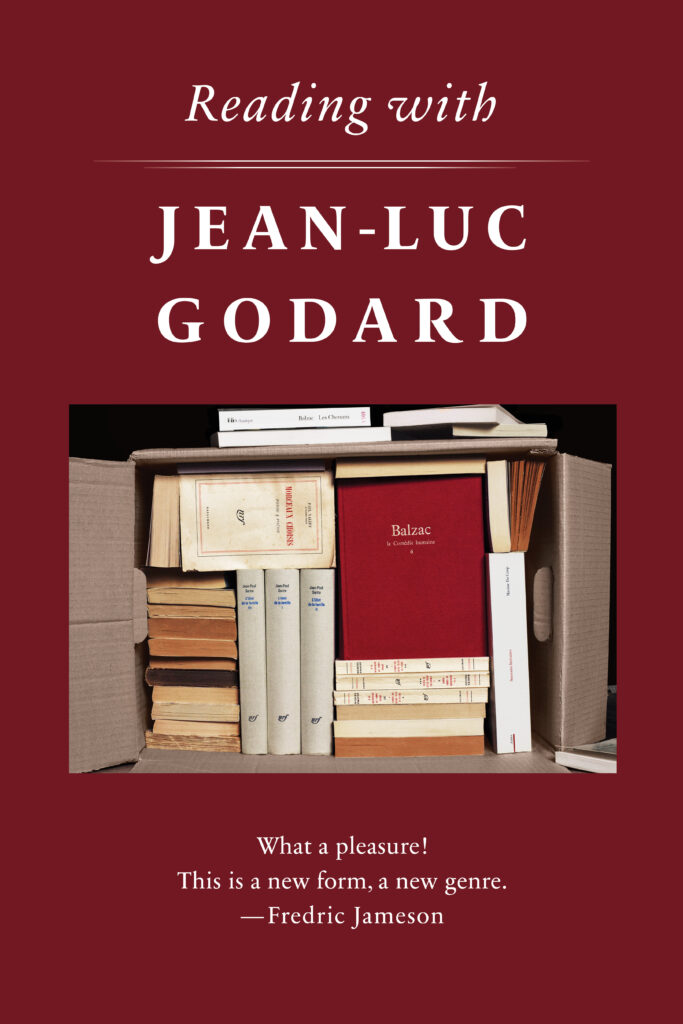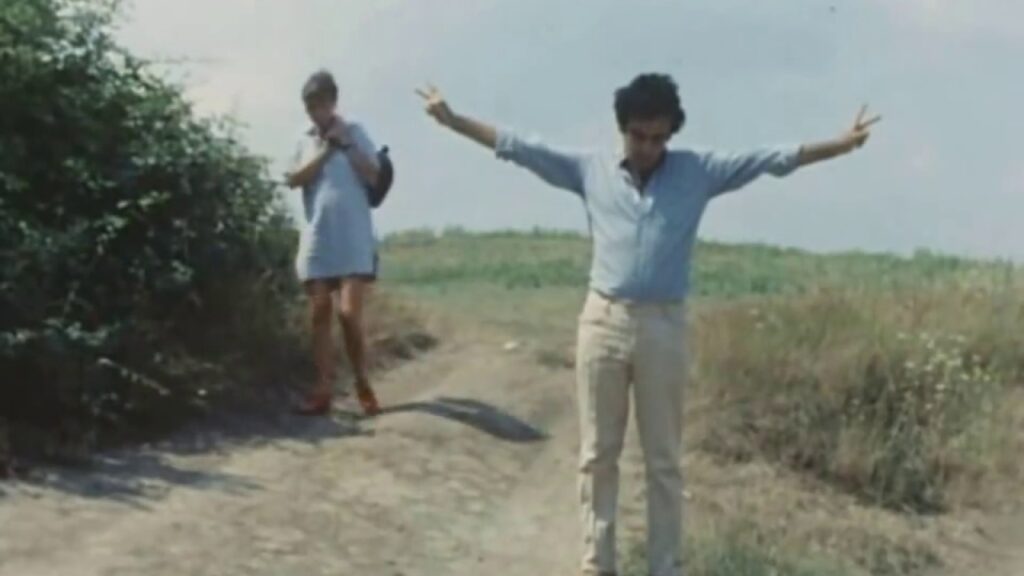Written for MUBI, who published it in January 2024.

According to the literary scholar Fredric Jameson, who contributes an enthusiastic preface and afterword, Reading with Jean-Luc Godard — a compendium of 109 three-page essays by 49 writers from a dozen countries — launches “a new form” and “a new genre”. It can be described as a user-friendly volume designed to occupy the same space between academia and journalism staked out by MUBI while proposing routes into Godard’s work provided by his eclectic reading — a batch of writers ranged alphabetically and intellectually from Louis Aragon, Robert Ardrey, Hannah Arendt, and Honoré de Balzac to François Truffaut, Paul Valéry, A.E. Van Vogt, and Virginia Woolf. (Full disclosure: I contributed one of the two pieces on Truffaut, devoted to how his best piece of Alfred Hitchcock criticism helped to shape Godard’s and why Truffaut omitted that major text from his own books.) Some authors, such as Marguerite Duras, Martin Heidegger, and Edgar Allan Poe, get more than one entry, and coeditor Timothy Barnard wrote all four of those devoted to André Malraux. Indeed, he and coeditor Kevin J. Hayes are responsible for almost half of the entries.
One of the book’s fringe benefits is canonical, offering a list of writers that includes many obscure names worthy of discovery. A hundred years ago, readers scoured the footnotes that T. S. Eliot added to his 1922 poem The Waste Land in the same fashion, to compile an ideal reading list. When Susan Sontag published her first collection of essays, Against Interpretation, in 1966, I similarly tended to use her less familiar names and titles as a helpful guide to my own self-appointed post-college curriculum. (In the same spirit, while living in Paris, I used the index of Noël Burch’s Praxis du cinéma to compile an ideal screening list of unseen films I needed to catch up with.) Reading with Jean-Luc Godard offers us something comparable — closer to Sontag’s hit parade than to Eliot’s insofar as it includes the fine arts, cinema, and politics as well as literature as its key cultural domains, albeit half a century later.
An important part of the gift bestowed by French film criticism on a more universal film culture, spearheaded by such American Francophiles as Andrew Sarris and Sontag, was its treatment of cinema as an art comparable to other arts and activities, all regarded in the present tense– literature, theater, painting, music, dance, politics. Part of this legacy was such new terms as auteur and mise en scène (the latter outfitted with hyphens that it lacked In French). Another part entailed countering the Hollywood business model of films losing their importance after ending their first runs with the notion of a more timeless and equitable pantheon, according to which the art of F.W. Murnau was pertinent to the art of Kenji Mizoguchi and/or Otto Preminger, much as one might connect the art of Rodin with that of Giocometti. Although commonly regarded as the gift of the French New Wave, this democratic attitude largely sprang from programming by Turkish-born Henri Langlois at the Cinémathèque Française (which he cofounded in 1936), who in effect trained the Nouvelle Vague filmmakers to think this way about the past, present, and future, so that Orson Welles could be related to Murnau and Eric von Stroheim as well as to Marcel Proust.
Published by the independent, Montreal-based caboose books, run by Barnard (known for his careful translations of André Bazin and Godard and diverse film-related monographs under his imprint), Reading with Jean-Luc Godard offers wider contexts for understanding Godard than skeleton keys –- another way of saying that, like Godard, it aims at deepening various mysteries rather than pretending to resolve them. Like Godard himself and his endlessly expanding universe of texts and authors, this collection can’t pretend to be exhaustive. There are no entries here on Roland Barthes (who turned down Godard’s invitation to appear in Alphaville), Lewis Carroll, Louis-Ferdinand Céline, Serge Daney, or Hollis Frampton, to cite only the first flagrant omissions that come to mind. Moreover, it’s usually an error to assume that Godard’s declarations are final conclusions rather than experimental probes into relatively unchartered areas where thoughts are necessarily trial balloons, all of them waiting to be popped or else redirected. “I like to think of myself as an airplane, not an airport.,” he said when I interviewed him in 1980, implying that people should regard him as a vehicle and not as a destination – a vehicle carrying them wherever they wanted to go.
To complicate matters, Godard misremembered certain quotations as well as their authors, and so have many of his would-be explicators. It was Luc Moullet who first linked camera movements to morality (“La morale est affaire de travellings”), but Godard received most of the credit by turning that provocation on its head (“Les travellings sont affaire de morale.”) He opened his masterpiece Contempt with a quote credited to Bazin that was actually his garbled memory of a statement by the lesser-known Michel Mourlet, who was only 23 when he wrote it, a few months after Bazin’s death. In Frankfurt professor Vinzenz Hediger’s entry on Mourlet, he argues that the “misattribution absorbs the quotation into the production logic of the film, a star-driven vehicle of cinephile reverence that evolves in a sphere reserved for iconic figures of cinema culture. If there is a gain in literary value in the misquotation, there is a gain in cinematic, even photogenic value in the misattribution.” Interviewing Godard about his Histoire(s) du cinéma, I tried in vain to convince him that the alleged “miracle” at the climax of Alfred Hitchcock’s The Wrong Man that he cites was actually a dramatic contrivance (as shown by the research of Marshall Deutelbaum) and not a function of Hitchcock’s declaration that “this is a true story, every word of it.”
But my issues with Godard’s scholarship have little to do with his value as a poet and film artist. He was a journalist full of catch phrases and poetic conceits before he was an established filmmaker, and he always remained a critic and essayist more than a storyteller. Journalism is often a matter of simplifications and shortcuts, with frequent recourses to mythology and iconography, and Godard’s fame derived from a keen sense of the contemporary world and how to convey this to others – critically, philosophically, poetically, visually, and even rhythmically, especially during the 1960s – even when this meant breaking all sorts of film industry rules In certain respects, his euphoric celebration of dabbling was an attempt to encompass the world — which is why he often read only the first and last sentences of books while browsing home libraries, got his romantic trio in Band of Outsiders to race through the Louvre, and even equated the world’s possessions with a stack of postcards, like the two louts in Les carabiniers. Yet because any attempt to consume the world is destined to fail, dabbling establishes a certain truce with ambition.
Consequently, Godard’s misunderstandings can be every bit as fruitful as his understandings, as Hediger suggests, and some of Reading’s entries spell out this paradox. Furthermore, JLG’s taste for quotations can be seen as a talent for reappropriation derived from outright pilfering: his periodic book thefts in his youth seem connected to a passion for borrowing/stealing the words of others, often altering and always repurposing them as part of his own discourse. What superficially resembles plagiarism is arguably something closer to bricolage — using a quote as a starting-point, a tool for tinkering rather than as any sort of desired end point. In his entry on art historian Élie Faure, Barnard cites an interview in which Godard is asked whether he’s a copyist, translator, or exegete when he quotes. He replies, “All three….They’re like counting rhymes you say over [and over] to yourself and then understand differently.”

In an entry on filmmaker Glauber Rocha, Brazilian professor Mateus Araújo charts a fascinating history of textual and physical encounters, starting with Godard attacking Rocha’s arrest by the Brazilian government without naming him in Masculine Feminine, continuing with Juliet Berto citing him by name as a valued colleague, and climaxing with Rocha appearing in Wind from the East to deliver a monologue at an Italian crossroads about the options of Third World cinema. Finally, Araújo concludes that Godard’s embrace of Rocha had more to do with his first texts translated into French than with his early features seen by Godard and his collaborator Jean-Pierre Gorin.
As someone who often regarded both his talk and his filmmaking as playful experiments — a means of testing ideas and the meanings of words rather than making any simple or final declarations with them — Godard typically confounds efforts to tie him to any single game plan. The most that many entries in this book can accomplish is to show how much fun these limited forays can be. Like one of Godard’s spidery, web-spinning blankets of wordplay suggesting other routes that imagination, coherence, or even ideology might take, they are brief interludes, fleeting fancies designed to illuminate and then, very politely, evaporate. If they stick around longer, that’s because we choose to resurrect them for future use and further collaborations.
Some entries run the risk of creating their own confusing entanglements around those of Godard. Coeditor Hayes, after effectively opening his take on Robert Bresson’s Notes on the Cinematograph by citing Godard’s 1957 assertion that Bresson’s place in French cinema equals Dostoevsky’s in Russian literature and Mozart’s in German music, becomes vaguer and fuzzier when he maintains that one of Bresson’s aphorisms is “slightly reworded” twice in the first chapter of Histoire(s) du cinéma, then used as the title of Pedro Costa’s Change Nothing, which is also (I believe) misdescribed as a musical film “composed entirely of rehearsals” (my emphasis). It’s certainly credible as well as useful to find ways of linking the practices of Bresson, Godard, and Costa. Yet attaching all three to the same cryptic fragment of one of Bresson’s Chinese-fortune-cookie aphorisms might be a bit of a stretch.
On the other hand, the frequent and inevitable oscillations between French and English and the complicated consequences of all the translations, occasionally fostering potential misunderstandings and awkward formulations en route, may be the true source of my periodic discomforts in tunneling through this volume. And of course, as Godard repeatedly demonstrated on his own, even up to his assisted suicide at the age of 92, discomfort can sometimes be a blessing, especially when it teaches us something.


